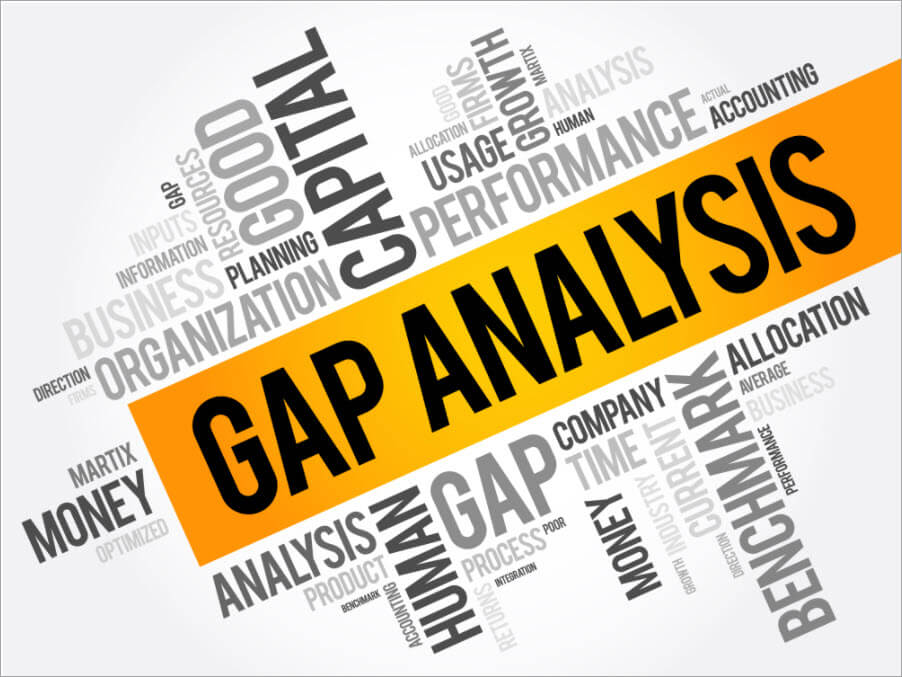Business organizations worldwide are constantly changing and rearranging their processes to meet the demands of the dynamic economy. The need to fix and expand their business processes to match the business objective is a continuous procedure. Gap analysis helps businesses in this aspect. With the help of gap analysis, companies can get a detailed explanation of their processes and evaluate their position in the market.
Gap analysis is not limited to any single industry. It can be applied in diverse areas like sales, productivity, financial performance, human resource management, cost control, quality assurance, employee satisfaction, market competitiveness, etc. Before going further into the significance of conducting a gap analysis, let us discuss what gap analysis is and its objectives.
Jump ahead to
What is Gap Analysis?
Gap analysis is a set of techniques to examine and describe the gap between the current performance and the desired future objectives.
It allows businesses to determine the best methods to achieve their goals and objectives. Using gap analysis, organizations can compare the present state of the company with the ideal state or the business objectives. This will help them find the shortcomings affecting the result and the opportunities that can help them expand the business further.
A gap analysis should be done frequently, especially with high stakes. This usually tells organizations about the progression and the direction of their business. It also helps organizations determine that their resources are utilized effectively to meet the business’s and its customers’ expectations.
Significance of Gap Analysis
The most important aspect of conducting a gap analysis is that it helps control the various facets of a business. Here are eight ways gap analysis can become significant in transforming your business:
- By using gap analysis, organizations can identify the shortcomings or deficiencies of the business and find ways to overcome them.
- It helps in quantifying these findings to help them make improvements for the future.
- Through gap analysis, organizations can prioritize tasks and processes that must be changed or improved to achieve the desired objectives.
- It assists leaders and decision-makers like project managers in making informed decisions about allocating resources, budget, and time according to business goals.
- Gap analysis promotes the efficiency of your business by analyzing and evaluating the problems in the various business processes.
- It forces business leaders to look at the entire business model objectively, which gives an in-depth look into their processes.
- Utilizing gap analysis also helps in managing the expectations of the workforce. Gaps between their expectations and work experience can seriously impact productivity.
- An effective gap analysis improves the business’s overall productivity by managing the expectations of the entire business operation with reality.
Gap analysis is an effective project management tool to improve the whole business, including the workforce. It clarifies your current position in the market and the direction you want to take. With gap analysis, organizations can track their progression and examine their steps to meet their visions and missions. Thus, adding value to the entire business.
Steps in Gap Analysis
Gap analysis usually involves four steps that organizations follow to analyze the progress of their business processes. These are as follows:
- Analyzing the current business position –
Firstly, organizations need to analyze their current business position to find the areas they need to improve to attain their goals and objectives. - Evaluating the current state of business with the business objectives with quantitative data –
This step focuses on the organizational objectives and compares the current business position with the desired goals through quantitative data. - Identifying gaps between the present state and the desired state –
In this step, the quantitative analysis identifies gaps between the current and desired business positions. - Assess the quantitative data to formulate an improvement plan –
In the final step of gap analysis, the data is utilized to devise solutions for improving the current business state to the desired one.
The aim of these steps is to bridge the gap between the present business state and the ideal business state. This requires a well-defined improvement plan approved by all the decision-makers of the business organization.
Tools
Organizations implement several tools to conduct a gap analysis. These tools help make the process easy and find effective solutions. Some of the most used gap analysis tools are:
- SWOT analysis
- Fishbone diagram
- McKinsey 7S framework
- Nadler-Tushman Model
- PESTELE analysis
Conclusion
Gap analysis is a valuable framework for assessing your business goals and objectives. Businesses rely on tools and techniques like gap analysis to survive in the dynamically changing global economy. Different techniques help organizations to transform their existing business to the ideal state. Gap analysis is one of the best methods of analyzing the gap between the present business position and the desired one.




